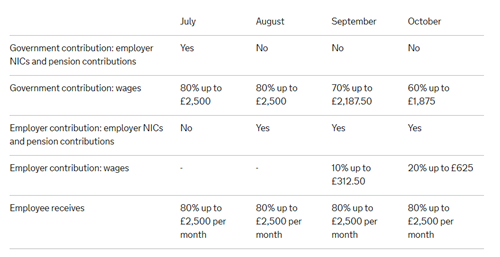Changes to the CJRS and Flexible Furlough and Future Considerations
The Government has published guidance with regards to the next steps for the Coronavirus Job Retention Scheme (CJRS) and furlough. We are now in July and the current furlough scheme has closed to new entrants, as of 30th June 2020.
Employers are now able to bring staff who have been furloughed back to work on a part-time basis. Employees can be brought back to work for any amount of time, and on any work pattern. Employers will pay staff for the hours worked and be able to claim through the CJRS for the non-working time. This is called flexible furlough. As part of the claim, the employer will need to report the hours that have been worked and what hours the employee would usually be required to work. Please note that employers must ensure that working agreements between the employer and employee, are confirmed in writing.
Furthermore, there will no longer be a three week minimum claim period for furloughed employees, this has changed to a minimum of one week (seven days).
Employers should also be aware that from the 1st August 2020 the level of the Government grant will start to reduce.
Important Dates to Note:
- 10th June 2020 – This was the final date that an employer could furlough an employee for the first time (due to the three week minimum furlough requirement). That is unless the employee is a parent returning from extended parental leave.
- 30th June 2020 – CJRS closed to new entrants.
- 1st July 2020 - This saw the introduction of the Government's flexible furlough scheme. Employees can now complete part-time work and employers can claim for the non-working time for their employees. (Although employers don’t have to bring staff back part-time). These claims are limited to months, with no overlapping months permitted.
- 31st July 2020 – This will be the final date for employers to make claims for the period up to and including 30th of July.
- 1st August 2020 – The CJRS will no longer fund any employer on-costs. Employers will be required to pay all employer NIC and Pension costs. However can still claim 80% of wage costs up to the monthly cap of £2500.
- 1st September 2020 – For the hours the employee does not work, the CJRS will fund 70% of wages only, up to a monthly cap of £2187.50. Employers will be required to contribute 10%, to make up the shortfall to 80%, up to a maximum of £2500 per month, as well as all employer on-costs for NIC and Pension.
- 1st October 2020 – For the hours the employee does not work, the CJRS will fund 60% of wages only, up to a monthly cap of £1875. Employer’s will be required to contribute 20%, to make up the shortfall to 80%, up to a maximum of £2500 per month, as well as all employer on-costs for NIC and Pension.
Contribution Rates Illustrated:
The HMRC has published the following table to help illustrate how the claim/ contribution rates are changing, (using an example of someone who is furloughed 100% of the time) N.B. wage caps are proportional to the hours not worked:

Staff Returning from Parental Leave:
On 9th June 2020 the government confirmed that parents on statutory maternity and paternity leave who return to work in the coming months after a long period of absence will be permitted to be furloughed, even after 10 June cut-off date. This also applies to people on adoption leave, shared parental leave, and parental bereavement leave.
Please note, this will only apply where they work for an employer who has previously furloughed employees.
Further Guidance on Calculations:
On the 12th June, the HMRC published further guidance on how claims under the flexible furlough scheme should be calculated. Details can be found here: https://www.gov.uk/guidance/calculate-how-much-you-can-claim-using-the-coronavirus-job-retention-scheme
Further Considerations for Employers:
Payslips and flexible furlough: In April 2019 the Government brought in a requirement for payslips to display hours worked, where this causes pay to vary. Employers bringing back staff part-time on flexible furlough will need to ensure the hours worked are visible on the payslip.
Post-Employment Notice Pay, Pay in Lieu of Notice and Redundancy Pay: Employers should ensure that where an employee has been furloughed, the figures in the calculations for the aforementioned payments, reflect full pay and not reduced furlough pay.
Average weekly earnings for Parental Leave: For periods of maternity leave beginning on or after 25 April 2020, if an employee was furloughed and on reduced wages during any part of the relevant calculation period, their SMP should be calculated using the pay they would have usually received, had they not been furloughed.
This legislation also extends to the calculation of statutory paternity, adoption, shared parental and parental bereavement pay and maternity allowance, where the affected employees have been furloughed.
Get in touch
Want to find out more? Get in touch and discover what Symatrix could do for your business. We’d love to chat.
